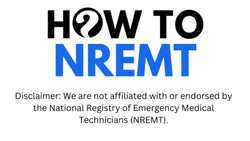Missing a deadline or misunderstanding a recertification fee can cost you your National Registry certification and potentially your job. We’ve seen it happen too many times. Whether you’re new to the process or it’s your third renewal, understanding how NREMT recertification works is essential. Staying ahead of deadlines and fee structures gives you peace of mind and ensures you can stay focused on providing the best patient care.
In this guide, we break down recertification fees, important deadlines, and how to avoid common last-minute mistakes. We'll also share quick tips to keep your credentials active and your NREMT test prep on track.
NREMT Recertification Fees: What to Expect
Knowing the recertification fee in advance can help you budget and avoid unnecessary stress. The current (as of 2025) recertification fees are as follows:
·EMR (Emergency Medical Responder): $18
·EMT (Emergency Medical Technician): $25
·AEMT (Advanced EMT): $26
·Paramedic: $32
These fees apply whether you submit your application online or by mail. However, online applications are processed faster and reduce the chances of human error or document loss.
Quick Tip: Save your payment confirmation receipt. If there’s a system error or delay, this proof could save you hours of follow-up later.
These fees are subject to change, so always verify the latest information directly from the NREMT fee schedule before submitting.

Late Renewal Penalties
If you miss your recertification deadline, you’re not out of luck just yet but there will be consequences.
·Late Renewal Window: You have up to 30 days after your certification expiration to complete renewal through the re-entry process.
·Additional Costs: You’ll need to pay for a new cognitive exam if your certification lapses beyond that grace period. This cost can be:
o EMT: $104
o AEMT: $136
o Paramedic: $160
Missing a deadline doesn’t just cost money; it can also delay your ability to work, especially in states where continuous certification is required by law.
Quick Tip: Set calendar alerts 3–6 months ahead of your deadline so you're not scrambling at the last minute.
NREMT Recertification Deadlines You Can’t Miss
Deadlines vary slightly by level, but the general recertification window for all certification levels is October 1 through March 31 each year.
Here’s how it breaks down:
o October 1: Application window opens
o March 31: Deadline to submit all required documentation and payment
o April 1: Expired status begins if not submitted
Once April hits, you’re officially out of compliance, and reentry becomes more complicated and expensive.
Quick Tip: Don’t wait until March to start your NREMT test prep. Aim to finish continuing education by January so you’re ready to submit early.

How the Application Process Affects Timelines
Submitting early helps in two key ways:
1. Gives Time for Corrections: If there’s an error, such as missing continuing education hours, payment issues, or incorrect documentation, you’ll still have time to fix it before the March 31 cutoff.
2. Avoids System Delays: The NREMT site sees high traffic in March. Early submissions reduce the risk of technical slowdowns or verification delays.
Whether you’re using the National Continued Competency Program (NCCP) model or state-based education requirements, timing is everything.
Pro Tip: We recommend logging into your NREMT account every January to check for any updates to your profile or submission steps.
Building Recertification Into Your NREMT Test Prep Plan
Your continuing education and NREMT test prep go hand in hand. The best NREMT prep plans include regular tracking of hours and course types. Here's how we handle it:
o Break education into monthly goals: Instead of doing 40+ hours in one month, we break it into 4–6 hour sessions monthly.
o Use NREMT-approved providers: Stick with CAPCE-accredited programs to ensure your hours will be accepted.
o Log everything immediately: Don’t wait to enter your CE hours. Add them to your NREMT account right after you complete a course.
By integrating CE tracking into your NREMT exam prep routine, you’ll avoid end-of-cycle panic and fee surprises.
Recommended Read: ID Requirements for the NREMT Exam: What to Bring on Test Day

Common Mistakes That Lead to Extra Fees
It’s easy to overlook small things that can lead to delays or worse, rejection. Here are the issues we see most often:
·Using non-approved CE providers
·Submitting incomplete applications
·Forgetting to sign the application before mailing
·Paying the wrong fee amount
·Relying solely on employer reminders
Remember: recertification is your responsibility, not your employer’s.
Quick Tip: Review your NREMT account status quarterly not just at recertification time. That way, you’ll spot errors or gaps before they become expensive problems.
Stay Ahead of Recertification with How To NREMT
At How To NREMT, we help you do more than pass. We help you stay certified for the long haul. Our expert-backed NREMT test prep tools are designed to fit your schedule, budget, and certification level.
With targeted practice questions, continuing education tips, and renewal reminders, we keep your progress on track.
Start your best NREMT prep today and skip the stress.

